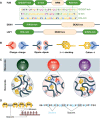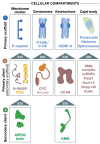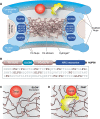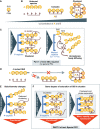On the role of phase separation in the biogenesis of membraneless compartments
- PMID: 35107832
- PMCID: PMC8886532
- DOI: 10.15252/embj.2021109952
On the role of phase separation in the biogenesis of membraneless compartments
Abstract
Molecular mechanistic biology has ushered us into the world of life's building blocks, revealing their interactions in macromolecular complexes and inspiring strategies for detailed functional interrogations. The biogenesis of membraneless cellular compartments, functional mesoscale subcellular locales devoid of strong internal order and delimiting membranes, is among mechanistic biology's most demanding current challenges. A developing paradigm, biomolecular phase separation, emphasizes solvation of the building blocks through low-affinity, weakly adhesive unspecific interactions as the driver of biogenesis of membraneless compartments. Here, I discuss the molecular underpinnings of the phase separation paradigm and demonstrate that validating its assumptions is much more challenging than hitherto appreciated. I also discuss that highly specific interactions, rather than unspecific ones, appear to be the main driver of biogenesis of subcellular compartments, while phase separation may be harnessed locally in selected instances to generate material properties tailored for specific functions, as exemplified by nucleocytoplasmic transport.
© 2022 The Author. Published under the terms of the CC BY 4.0 license.
Figures







References
-
- Alberti S, Hyman AA (2021) Biomolecular condensates at the nexus of cellular stress, protein aggregation disease and ageing. Nat Rev Mol Cell Biol 22: 196–213 - PubMed
-
- Aloy P, Ceulemans H, Stark A, Russell RB (2003) The relationship between sequence and interaction divergence in proteins. J Mol Biol 332: 989–998 - PubMed
Publication types
MeSH terms
Substances
LinkOut - more resources
Full Text Sources

